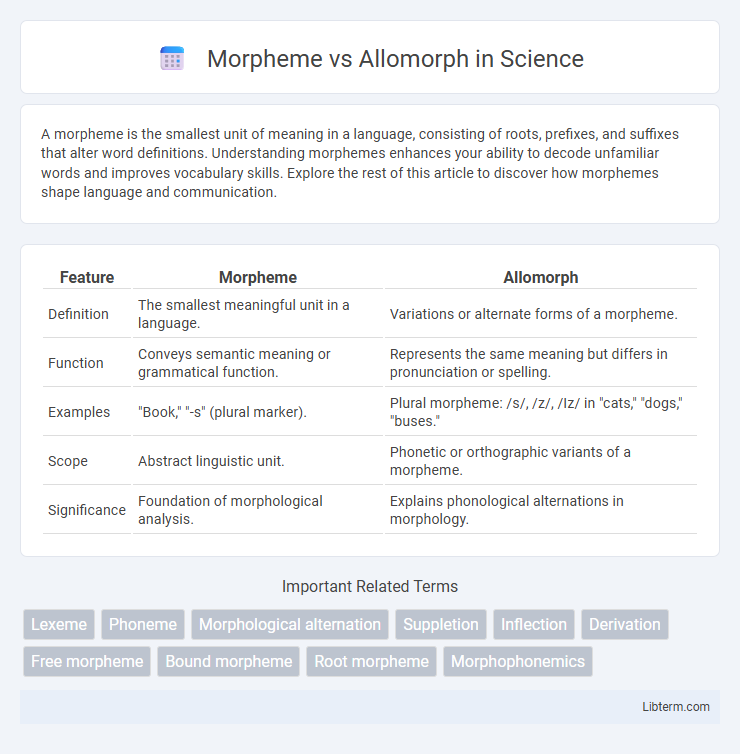A morpheme is the smallest unit of meaning in a language, consisting of roots, prefixes, and suffixes that alter word definitions. Understanding morphemes enhances your ability to decode unfamiliar words and improves vocabulary skills. Explore the rest of this article to discover how morphemes shape language and communication.
Table of Comparison
| Feature | Morpheme | Allomorph |
|---|---|---|
| Definition | The smallest meaningful unit in a language. | Variations or alternate forms of a morpheme. |
| Function | Conveys semantic meaning or grammatical function. | Represents the same meaning but differs in pronunciation or spelling. |
| Examples | "Book," "-s" (plural marker). | Plural morpheme: /s/, /z/, /Iz/ in "cats," "dogs," "buses." |
| Scope | Abstract linguistic unit. | Phonetic or orthographic variants of a morpheme. |
| Significance | Foundation of morphological analysis. | Explains phonological alternations in morphology. |
Introduction to Morphemes and Allomorphs
Morphemes are the smallest units of meaning in a language, serving as the building blocks of words, such as roots, prefixes, and suffixes. Allomorphs represent the variant forms of a single morpheme that occur due to phonological, morphological, or contextual factors, for example, the plural morpheme appearing as /s/, /z/, or /Iz/ in English. Understanding the distinction between morphemes and allomorphs is essential for linguistic analysis, morphology, and language processing.
Definition of Morpheme
A morpheme is the smallest grammatical unit in a language that carries meaning, such as roots, prefixes, and suffixes. Unlike allomorphs, which are variant forms or pronunciations of a morpheme depending on phonetic or morphological context, a morpheme itself represents the abstract unit of meaning. Morphemes serve as the foundational building blocks for word formation and semantic interpretation across languages.
Types of Morphemes
Morphemes are the smallest units of meaning in a language, categorized into free morphemes, which can stand alone as words, and bound morphemes, which must attach to other morphemes. Bound morphemes include inflectional morphemes, altering tense or number without changing word class, and derivational morphemes, which create new words or change grammatical categories. Allomorphs are variant forms of a single morpheme that differ in pronunciation or spelling but maintain the same semantic function within these types of morphemes.
Understanding Allomorphs
Allomorphs are the variant forms of a single morpheme that differ in pronunciation or spelling but carry the same meaning, such as the English plural morpheme represented by /s/, /z/, and /Iz/ sounds. Understanding allomorphs requires recognizing patterns of phonological or morphological context that trigger these variations, like the plural "-s" pronounced as /s/ in "cats," /z/ in "dogs," and /Iz/ in "horses." The study of allomorphs is essential for linguistic analysis of morphological processes and accurate language processing in natural language understanding systems.
Key Differences Between Morpheme and Allomorph
A morpheme is the smallest meaningful unit of language, representing a specific semantic or grammatical function, while an allomorph is a variant form of a morpheme that appears in different phonological or contextual environments without altering its meaning. Morphemes maintain consistent meaning across various contexts, whereas allomorphs exhibit phonetic variation conditioned by surrounding sounds or morphological rules. Key differences include that morphemes are abstract linguistic units, and allomorphs are their surface realizations, highlighting the relationship between underlying linguistic structure and phonetic expression.
Examples of Morphemes in English
Morphemes in English include prefixes like "un-" in "undo," suffixes such as "-ed" in "walked," and root words like "book" in "notebook," representing the smallest units of meaning. Allomorphs are variant forms of a morpheme, exemplified by the plural morpheme in English, which appears as /s/ in "cats," /z/ in "dogs," and /Iz/ in "horses." Understanding these examples clarifies how morphemes function as core meaning units while allomorphs reflect phonetic variations conditioned by context.
Common Allomorphs and Their Usage
Common allomorphs include variations like /s/, /z/, and /Iz/ for the English plural morpheme, which appear depending on the final sound of the root word. For instance, the plural morpheme is pronounced /s/ after voiceless consonants (cats), /z/ after voiced consonants and vowels (dogs), and /Iz/ after sibilant sounds (buses). These allomorphs demonstrate how phonological context influences morpheme realization without altering meaning.
Functions of Morphemes in Language Structure
Morphemes serve as the smallest units of meaning in language, functioning to build vocabulary and convey grammatical relationships through roots, prefixes, and suffixes. Allomorphs represent the variant forms a single morpheme can take depending on phonological or morphological context, ensuring phonetic harmony and ease of pronunciation within word structures. Understanding morphemes and their allomorphs reveals how languages encode meaning and grammatical nuances efficiently.
Morphological Analysis: Morphemes vs Allomorphs
Morphological analysis distinguishes morphemes as the smallest meaning-bearing units of language, while allomorphs are their variant phonetic forms that occur due to phonological or contextual changes. Each morpheme can have multiple allomorphs, which do not alter the underlying meaning but reflect pronunciation or orthographic adjustments, such as the plural morpheme in English appearing as /s/, /z/, or /Iz/. Understanding the relationship between morphemes and allomorphs is essential for precise linguistic parsing and accurate language modeling.
Importance of Morphemes and Allomorphs in Linguistics
Morphemes are the smallest meaningful units in a language, fundamental for understanding word formation and syntax, while allomorphs represent their variant forms, crucial for phonological analysis and morphological variation. Studying morphemes and allomorphs enhances linguistic theory by revealing patterns of language acquisition, evolution, and grammatical structure. This knowledge supports effective language teaching, lexicography, and natural language processing applications by improving the accuracy of morphological parsing and semantic interpretation.
Morpheme Infographic

 libterm.com
libterm.com